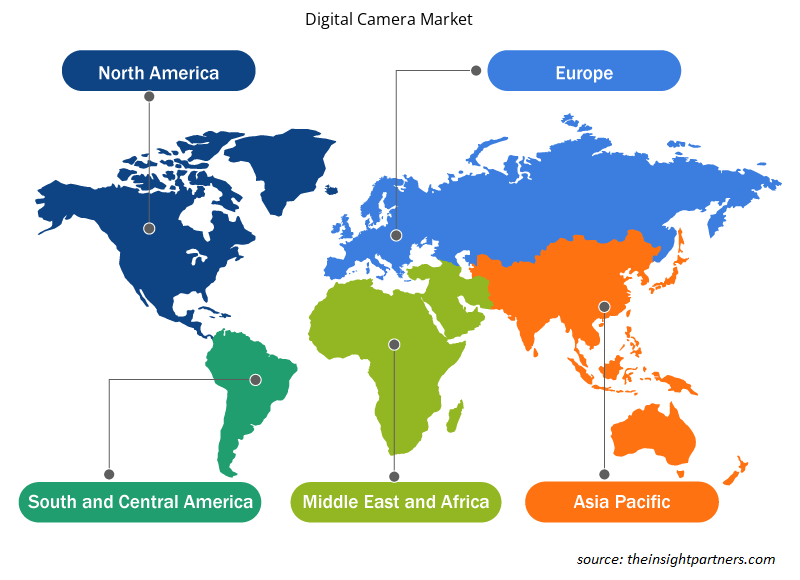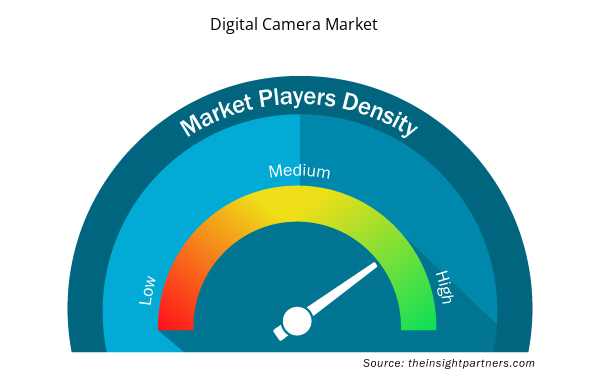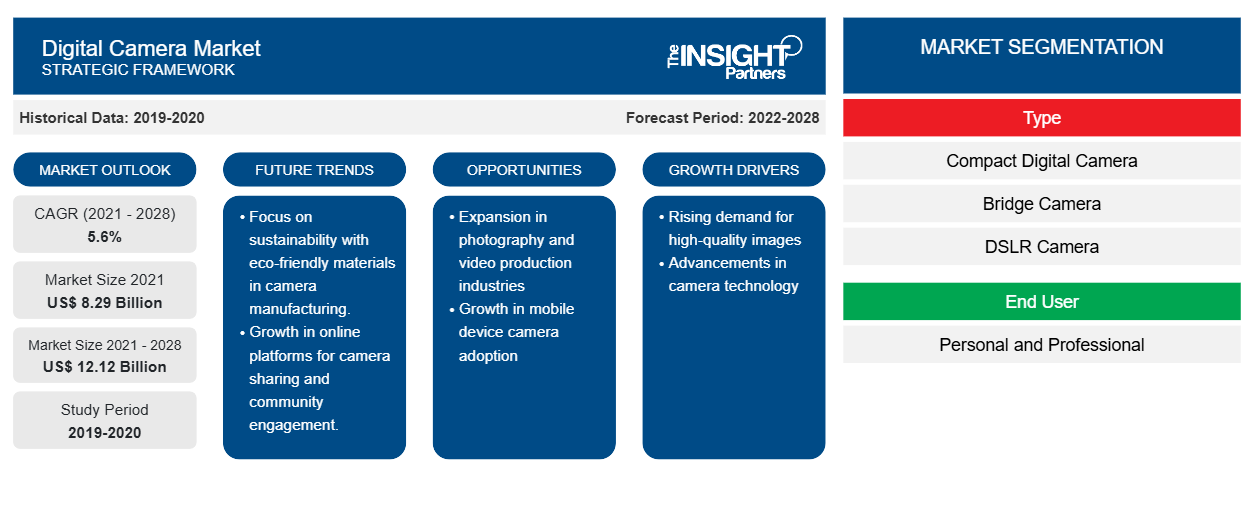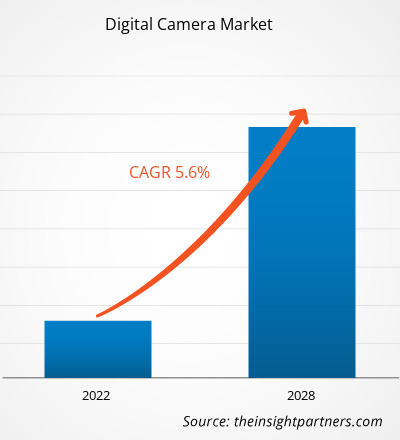预计数码相机市场规模将从 2021 年的 82.9025 亿美元增长到 2028 年的 121.1944 亿美元;预计 2021-2028 年期间的复合年增长率为 5.6%。
数码相机的使用不仅限于个人和专业摄影,还扩展到娱乐、媒体和体育行业。电影业是全球娱乐业中规模最大、利润最高的类别之一。例如,中国电影业是世界上最大的电影产业之一,2016 年收入约为 66 亿美元。电影和娱乐业的良好前景预计将推动对数码相机的需求,以实现完美的镜头和视频。快速的技术变化、消费者行为和商业模式改变了消费者体验和支付娱乐和媒体的方式。该行业的领导者专注于建立以粉丝为中心的业务和品牌,以制作出色的内容。因此,他们在技术和设备上投入了大量资金,例如计算机生成图像 (CGI) 和视觉效果 (VFX) 以及先进的相机。
此外,体育媒体也不可或缺地使用数码相机。在体育场安装高速数码相机可以让观众在关键比赛时刻看到慢动作回放,有助于在观看时获得准确性。同样,在野生动物、风景、建筑和工作室摄影中使用高分辨率数码相机有助于获得清晰锐利的图像和视频。人们对动作摄影的关注度不断上升,这随后推动了对 GoPro 等紧凑型数码相机的需求。此外,Instagram 等社交媒体平台大大扩展了摄影的范围,这反过来又有望促进数码相机市场的增长
定制此报告以满足您的需求
您可以免费定制任何报告,包括本报告的部分内容、国家级分析、Excel 数据包,以及为初创企业和大学提供优惠和折扣
- 获取此报告的关键市场趋势。这个免费样品将包括数据分析,从市场趋势到估计和预测。
COVID-19 疫情对欧洲数码相机市场的影响:
由于封锁、旅行禁令和企业停业,冠状病毒大流行影响了各国的经济和行业。由于这次大流行,消费电子行业是遭受严重破坏的主要行业之一,例如供应链中断、生产工厂停工等。北美、欧洲、亚太、南美、中东和非洲等主要地区的各种制造工厂和工厂的关闭影响了全球供应链,并对各种商品的制造、交付计划和销售产生了负面影响。此外,各公司已经宣布产品交付可能延迟,未来产品销售下滑。除此之外,欧洲、亚洲和北美国家实施的全球旅行禁令正在影响商业合作和伙伴关系机会。所有这些因素预计都会对消费电子行业产生负面影响,从而成为未来几个月与该行业相关的各个市场增长的制约因素。由于生产不足以及运输设施有限,数码相机市场受到大流行的影响。
数码相机市场洞察
与数码相机相关的技术创新推动数码相机市场的增长
数码相机市场的框架与新兴的激进趋势密切相关,这些趋势以创新的技术发展和强劲的进步为后盾,例如高清和触摸屏。长期以来,由于消费者对高级摄影的倾向日益增加,市场对数码单反相机和单反相机市场的需求不断增加。然而,技术的进步导致了高分辨率相机的诞生,可提供 12-20 兆像素。数码相机领域的不断发展导致设计出具有更好分辨率、更快对焦速度和对不同外围设备支持的先进相机。此外,人们还观察到在数码相机中加入 Wi-Fi 或 4G 调制解调器的趋势日益增加,以提供相对于智能手机的竞争优势。此外,预计此类相机将成为多种互联设备的一部分,例如物联网 (IoT),这可以在不久的将来促进与其他互联设备(如智能手机和扬声器助手)的有效通信。
基于类型的市场洞察
根据类型,数码相机市场分为紧凑型数码相机、桥式相机、单反相机、无反光镜相机、数字测距相机和线扫描相机。2020 年,单反相机占据了市场的最大份额。
数码相机市场区域洞察
Insight Partners 的分析师已详尽解释了预测期内影响数码相机市场的区域趋势和因素。本节还讨论了北美、欧洲、亚太地区、中东和非洲以及南美和中美洲的数码相机市场细分和地理位置。

- 获取数码相机市场的区域特定数据
数码相机市场报告范围
| 报告属性 | 细节 |
|---|---|
| 2021 年市场规模 | 82.9亿美元 |
| 2028 年市场规模 | 121.2亿美元 |
| 全球复合年增长率(2021 - 2028) | 5.6% |
| 史料 | 2019-2020 |
| 预测期 | 2022-2028 |
| 涵盖的领域 | 按类型
|
| 覆盖地区和国家 | 北美
|
| 市场领导者和主要公司简介 |
|
市场参与者密度:了解其对商业动态的影响
数码相机市场正在快速增长,这得益于终端用户需求的不断增长,而这些需求又源于消费者偏好的不断变化、技术进步以及对产品优势的认识不断提高等因素。随着需求的增加,企业正在扩大其产品范围,进行创新以满足消费者的需求,并利用新兴趋势,从而进一步推动市场增长。
市场参与者密度是指在特定市场或行业内运营的企业或公司的分布情况。它表明在给定市场空间中,相对于其规模或总市场价值,有多少竞争对手(市场参与者)存在。
在数码相机市场运营的主要公司有:
- 佳能公司
- 伊士曼柯达公司(JK Imaging Ltd.)
- 富士胶片控股株式会社
- 徕卡相机股份公司
- 尼康公司
免责声明:上面列出的公司没有按照任何特定顺序排列。

- 了解数码相机市场主要参与者概况
基于最终用户的市场洞察
根据应用,数码相机市场分为个人相机和专业相机。2020 年,专业相机占据了更大的市场份额。
数字市场参与者采用合并、收购和市场计划等策略来保持其市场地位。以下列出了一些主要参与者的发展:
- 富士胶片控股株式会社于 2021 年 2 月下旬宣布推出 FUJIFILM GFX100S。该相机是 GFX 系列无反光镜数码相机的最新成员。
- 尼康公司推出了 Z 7II 全画幅无反光镜相机。Z 7II 是一款全画幅、高分辨率无反光镜相机。通过这样的产品发布,该公司正在为影像文化的发展做出贡献。
数码相机市场细分如下:
按类型
- 小型数码相机
- 桥梁相机
- 单反相机
- 无反光镜相机
- 数码旁轴相机
- 线扫描相机
按最终用户
- 个人的
- 专业的
按地理位置
北美
- 我们
- 加拿大
- 墨西哥
欧洲
- 法国
- 德国
- 意大利
- 英国
- 俄罗斯
- 欧洲其他地区
亚太地区 (APAC)
- 中国
- 印度
- 韩国
- 日本
- 澳大利亚
- 亚太地区其他地区
中东和非洲 (MEA)
- 南非
- 沙特阿拉伯
- 阿联酋
- MEA 其他地区
南美洲 (SAM)
- 巴西
- 阿根廷
- SAM 其余部分
公司简介
- 佳能公司
- 伊士曼柯达公司
- 富士胶片控股株式会社
- 徕卡相机股份公司
- 尼康公司
- Om 数字解决方案公司
- 松下公司
- 哈苏
- 理光成像有限公司
- 索尼公司
- 历史分析(2 年)、基准年、预测(7 年)及复合年增长率
- PEST 和 SWOT 分析
- 市场规模价值/数量 - 全球、区域、国家
- 行业和竞争格局
- Excel 数据集


- Emergency Department Information System (EDIS) Market
- Thermal Energy Storage Market
- Sports Technology Market
- Transdermal Drug Delivery System Market
- Sodium Bicarbonate Market
- Virtual Production Market
- Medical Audiometer Devices Market
- Small Internal Combustion Engine Market
- Print Management Software Market
- Clear Aligners Market

Report Coverage
Revenue forecast, Company Analysis, Industry landscape, Growth factors, and Trends

Segment Covered
This text is related
to segments covered.

Regional Scope
North America, Europe, Asia Pacific, Middle East & Africa, South & Central America

Country Scope
This text is related
to country scope.
常见问题
DSLR cameras held the largest share in 2020 and they are the most versatile, high-end, and advanced type cameras. These cameras use single-lens reflex method. They consist of a mirror, which reflects the light passing through the lens. DSLR cameras are mostly large in size. These cameras are mainly used by professional photographers or videographers for commercial purposes. Automatic mode and changeable camera lens to fit different situations are the important feature of DSLR cameras. However, DSLR camera manufacturers are now focusing on integrating software enhancements and other technologies in these cameras for enhanced consumer experience, this factor is expected to drive the demand in the coming years.
With the growing trend toward photography, the demand for digital cameras is expanding. Digital camera allows to capture and store photos and videos digitally rather than printing it to film as per traditional analog cameras. As the consumers are becoming enthusiastic toward sight capturing, the demand for compact, lightweight, and high-quality cameras is rising. Further, the introduction of digital cameras and smartphones has created photography a mainstream profession, which have subsequently generated the need for high quality cameras with user-friendly interface and affordable price.
Mirrorless cameras are expected to drive the future growth of digital camera market. A mirrorless system camera does not involve a mirror box within its body and are designed with a compact and attractive exterior with an electronic viewfinder paired with interchangeable lens. Such cameras offer convenience in use compared to digital SLR cameras owing to their smaller and lighter structure. Mirrorless camera comprises lens at the front body along with sensor placed inside and a screen along with an optional viewfinder placed at the back. Additionally, such cameras have small, short, and light lenses and are constructed with a tiny LED or OLED screen, which helps to deliver best possible results altogether. Hence, the expanding demand for mirrorless cameras is expected to create lucrative opportunities for the growth of the digital cameras market.
Trends and growth analysis reports related to Electronics and Semiconductor : READ MORE..
The List of Companies - Digital Camera Market
- Canon Inc.
- Eastman Kodak Company (JK Imaging Ltd.)
- Fujifilm Holdings Corporation
- Leica Camera Ag
- Nikon Corporation
- Om Digital Solutions Corporation
- Panasonic Corporation
- Hasselblad
- Ricoh Imaging Company, Ltd
- Sony Corporation
The Insight Partners performs research in 4 major stages: Data Collection & Secondary Research, Primary Research, Data Analysis and Data Triangulation & Final Review.
- Data Collection and Secondary Research:
As a market research and consulting firm operating from a decade, we have published and advised several client across the globe. First step for any study will start with an assessment of currently available data and insights from existing reports. Further, historical and current market information is collected from Investor Presentations, Annual Reports, SEC Filings, etc., and other information related to company’s performance and market positioning are gathered from Paid Databases (Factiva, Hoovers, and Reuters) and various other publications available in public domain.
Several associations trade associates, technical forums, institutes, societies and organization are accessed to gain technical as well as market related insights through their publications such as research papers, blogs and press releases related to the studies are referred to get cues about the market. Further, white papers, journals, magazines, and other news articles published in last 3 years are scrutinized and analyzed to understand the current market trends.
- Primary Research:
The primarily interview analysis comprise of data obtained from industry participants interview and answers to survey questions gathered by in-house primary team.
For primary research, interviews are conducted with industry experts/CEOs/Marketing Managers/VPs/Subject Matter Experts from both demand and supply side to get a 360-degree view of the market. The primary team conducts several interviews based on the complexity of the markets to understand the various market trends and dynamics which makes research more credible and precise.
A typical research interview fulfils the following functions:
- Provides first-hand information on the market size, market trends, growth trends, competitive landscape, and outlook
- Validates and strengthens in-house secondary research findings
- Develops the analysis team’s expertise and market understanding
Primary research involves email interactions and telephone interviews for each market, category, segment, and sub-segment across geographies. The participants who typically take part in such a process include, but are not limited to:
- Industry participants: VPs, business development managers, market intelligence managers and national sales managers
- Outside experts: Valuation experts, research analysts and key opinion leaders specializing in the electronics and semiconductor industry.
Below is the breakup of our primary respondents by company, designation, and region:

Once we receive the confirmation from primary research sources or primary respondents, we finalize the base year market estimation and forecast the data as per the macroeconomic and microeconomic factors assessed during data collection.
- Data Analysis:
Once data is validated through both secondary as well as primary respondents, we finalize the market estimations by hypothesis formulation and factor analysis at regional and country level.
- Macro-Economic Factor Analysis:
We analyse macroeconomic indicators such the gross domestic product (GDP), increase in the demand for goods and services across industries, technological advancement, regional economic growth, governmental policies, the influence of COVID-19, PEST analysis, and other aspects. This analysis aids in setting benchmarks for various nations/regions and approximating market splits. Additionally, the general trend of the aforementioned components aid in determining the market's development possibilities.
- Country Level Data:
Various factors that are especially aligned to the country are taken into account to determine the market size for a certain area and country, including the presence of vendors, such as headquarters and offices, the country's GDP, demand patterns, and industry growth. To comprehend the market dynamics for the nation, a number of growth variables, inhibitors, application areas, and current market trends are researched. The aforementioned elements aid in determining the country's overall market's growth potential.
- Company Profile:
The “Table of Contents” is formulated by listing and analyzing more than 25 - 30 companies operating in the market ecosystem across geographies. However, we profile only 10 companies as a standard practice in our syndicate reports. These 10 companies comprise leading, emerging, and regional players. Nonetheless, our analysis is not restricted to the 10 listed companies, we also analyze other companies present in the market to develop a holistic view and understand the prevailing trends. The “Company Profiles” section in the report covers key facts, business description, products & services, financial information, SWOT analysis, and key developments. The financial information presented is extracted from the annual reports and official documents of the publicly listed companies. Upon collecting the information for the sections of respective companies, we verify them via various primary sources and then compile the data in respective company profiles. The company level information helps us in deriving the base number as well as in forecasting the market size.
- Developing Base Number:
Aggregation of sales statistics (2020-2022) and macro-economic factor, and other secondary and primary research insights are utilized to arrive at base number and related market shares for 2022. The data gaps are identified in this step and relevant market data is analyzed, collected from paid primary interviews or databases. On finalizing the base year market size, forecasts are developed on the basis of macro-economic, industry and market growth factors and company level analysis.
- Data Triangulation and Final Review:
The market findings and base year market size calculations are validated from supply as well as demand side. Demand side validations are based on macro-economic factor analysis and benchmarks for respective regions and countries. In case of supply side validations, revenues of major companies are estimated (in case not available) based on industry benchmark, approximate number of employees, product portfolio, and primary interviews revenues are gathered. Further revenue from target product/service segment is assessed to avoid overshooting of market statistics. In case of heavy deviations between supply and demand side values, all thes steps are repeated to achieve synchronization.
We follow an iterative model, wherein we share our research findings with Subject Matter Experts (SME’s) and Key Opinion Leaders (KOLs) until consensus view of the market is not formulated – this model negates any drastic deviation in the opinions of experts. Only validated and universally acceptable research findings are quoted in our reports.
We have important check points that we use to validate our research findings – which we call – data triangulation, where we validate the information, we generate from secondary sources with primary interviews and then we re-validate with our internal data bases and Subject matter experts. This comprehensive model enables us to deliver high quality, reliable data in shortest possible time.


 获取此报告的免费样本
获取此报告的免费样本